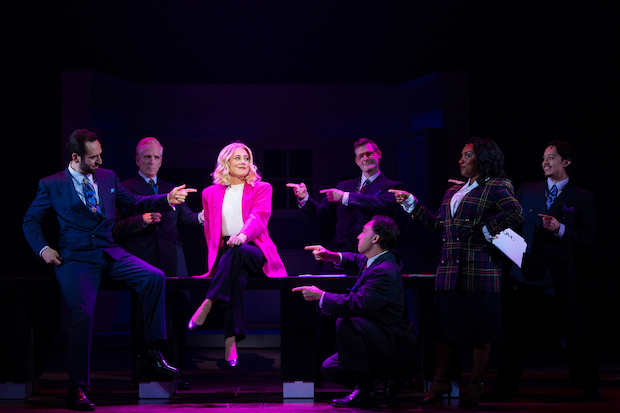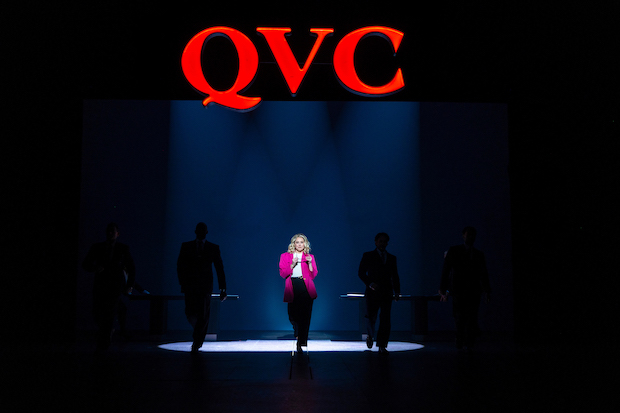Review: In Joy the Story of the Miracle Mop's Creator Is Given a Little Too Much Shine
The new musical, starring Erika Henningsen, is having its world premiere at the George Street Playhouse.

(© T Charles Erickson)
The emotional high point of Joy comes when the title character sings a spirited paean to her mop. The world-premiere musical at George Street Playhouse in New Brunswick, New Jersey, chronicles QVC superstar Joy Mangano's rise from harried single mom on Long Island to the queen of clean, all thanks to her Miracle Mop.
Strange as it sounds, this concept could work. Memorable musicals require a bit of spilled milk. But creators Ken Davenport (book) and AnnMarie Milazzo (music and lyrics) put too much stock in the utility of their subject's creation. The interesting dirt that litters Mangano's life, both good and bad, often gets wiped away too quickly. While hardly a hagiography, her image ends up fairly sanitized.
That's a shame, since Mangano's compelling backstory is arguably as responsible for her notoriety as her quotidian invention. In the early 1990s, Joy (Erika Henningsen) found herself unemployed, divorced, and struggling to provide for her preteen daughter Christie (the winning young actor Sami Bray). She also supports her agoraphobic mother, Toots (Vicki Lewis), and her sleazy but goodhearted father, Rudy (Stephen DeRosa), while putting up with the frequent entreaties of her ex-husband, Tony (Trent Saunders).
A brief prologue presents Joy as an inventor from childhood, creating an illuminated dog collar that is visible to oncoming cars. As the story shifts to her complicated later life, she patents a cleaning apparatus that allows its user to ring it out without bending over and aggravating back problems.

(© T Charles Erickson)
Her real triumph, though, lies in her ability as a saleswoman. In one of the score's more successful numbers, a gaggle of home shopping executives intone the simple message that keeps their industry afloat: "We sell stories." No one understood that better than Mangano, who connected with working parents like herself looking for anything to make their lives just a little easier.
Joy hasn't yet settled on the story it wants to sell. The major-key music and broadly telegraphed characterizations in the libretto linger on the positive aspects of Mangano's life. Here she conquers adversity without ever fully facing it. Put simply: the musical only tells half the story.
This is partially due to the creative team's decision to focus on a narrow sliver of Mangano's life, centered on the launch of her first successful product. The audience gleans only the slimmest details of her personal history, with many elements overlooked or entirely elided. (Christie is presented here as an only child, for example, although the real Mangano is a mother of three.) Conflict is kept largely to quick asides and throwaway lines that leave the overall picture of her life seeming hollow. Even with an extended intermission, the musical barely breaks the two-hour mark, and it's the rare new show that could benefit from additions rather than cutting.
Since Joy herself remains the focal point throughout the show, she can overcome the sketchiness of this dramaturgical approach. The other characters suffer. Toots's anxious aversion to leaving the house is played almost entirely for comedy, which minimizes the pathos when she finally overcomes her affliction to support Joy in her hour of need. You don't care enough about her journey for the moment to feel appropriately triumphant. And while Lewis remains a warm presence onstage, her barnstorming number "Mother's Daughter" sits awkwardly between register breaks.

(© T Charles Erickson)
Similarly, the musical waits too long to introduce any real stakes, and when it does late in the second act, they're resolved in short order. A patent dispute with a duplicitous Texas manufacturer (played with mustache-twirling malevolence by John Hickock) lacks drama because it is portrayed too baldly as a struggle between good and evil, with Joy's ultimate victory never in doubt. But this subplot does allow choreographer Joshua Bergasse to let loose with a splashy hoedown-style musical number, "Little Lady."
Most to the point, we never truly see the mop in action, nor does Mangano ever fully hawk her wares to the audience. As a stand-in for her customers, we should experience that frenzy firsthand. The score could stand to lose one of the several same-sounding anthemic numbers about Joy's tenacity in favor of showing the goods that made her a star. It might also give Henningsen an opportunity to layer her pleasant but ultimately general performance.
Casey Hushion's flashy direction, Anna Louizos's sleek sets, and the lengthy list of associate producers in the program all suggest that Joy has its sights set on larger stages. It might well make it there. The bones are good enough, and the musical theater canon is full of protagonists who spin triumph out of tragedy. The creative team still needs to take a lesson from Joy Mangano the master marketer: figure out what story you want to sell.











